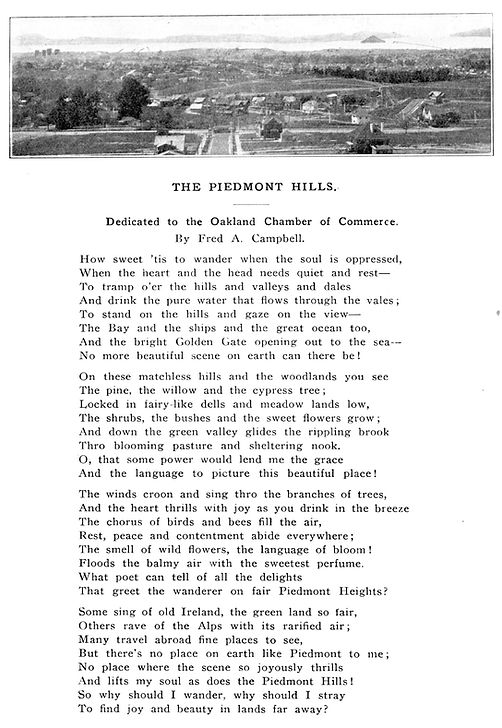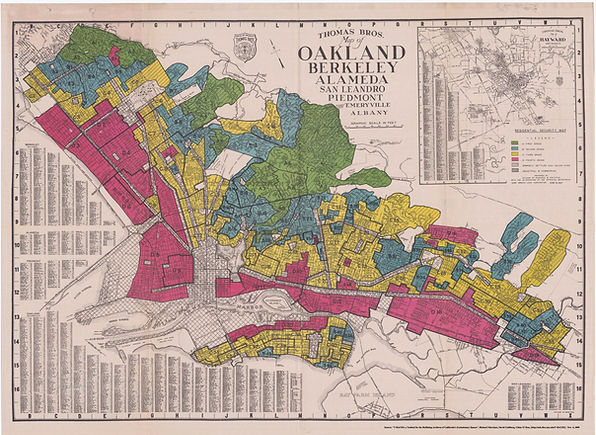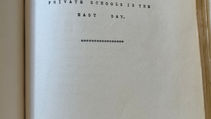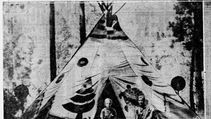Homes in Piedmont


THE PIEDMONT HILLS.
Dedicated to the Oakland Chamber of Commerce.
By Fred A. Campbell. (~1910)
How sweet 'tis to wander when the soul is oppressed,
When the heart and the head needs quiet and rest—
To tramp o'er the hills and valleys and dales
And drink the pure water that flows through the vales;
To stand on the hills and gaze on the view-
The Bay and the ships and the great ocean too,
And the bright Golden Gate opening out to the sea--
No more beautiful scene on earth can there be!
On these matchless hills and the woodlands you see
The pine, the willow and the cypress tree;
Locked in fairy-like dells and meadow lands low,
The shrubs, the bushes and the sweet flowers grow;
And down the green valley glides the rippling brook
Thro blooming pasture and sheltering nook.
O, that some power would lend me the grace
And the language to picture this beautiful place!
The winds croon and sing thro the branches of trees,
And the heart thrills with joy as you drink in the breeze
The chorus of birds and bees fill the air,
Rest, peace and contentment abide everywhere;
The smell of wild flowers, the language of bloom!
Floods the balmy air with the sweetest perfume.
What poet can tell of all the delights
That greet the wanderer on fair Piedmont Heights?
Some sing of old Ireland, the green land so fair,
Others rave of the Alps with its rarified air;
Many travel abroad fine places to see,
But there's no place on earth like Piedmont to me;
No place where the scene so joyously thrills
And lifts my soul as does the Piedmont Hills!
So why should I wander, why should I stray
To find joy and beauty in lands far away?

In the 1880's there were only seven houses where the City of Piedmont is now. Mr. Gamble's house and gardens filled up the whole block where the Recreation Center, pool and tennis courts are now, but his house was not the biggest. The biggest house was owned by Isaac and Sarah Requa. It was painted yellow and because there were no trees on the hills, sailors could see the house from San Francisco Bay. The Requa's called their house "The Highlands" and Highland Avenue is named after it. Another house at the corner of Vista and Bonita Avenues belonged to Jesse Wetmore, and that house still looks just like it did over a hundred years ago.
Piedmont Exedra January 25, 2020:
Frank C. Havens, had made a small fortune as a broker in the early days of the San Francisco Stock Exchange. In 1895 he partnered with Francis Marion Smith—the “Borax King of Death Valley” who would use his millions to build the Key System, an early East Bay private mass transit system that was the forebear of today’s AC Transit. Together Havens and Smith formed a firm they called the Realty Syndicate; Smith was responsible for laying transportation infrastructure, and Havens for developing the land it ran through.
“His plan, which was brilliant, was to buy as much land as he could,” the historian Swift said of Havens.
Across the East Bay the Syndicate owned 13,000 acres. These holdings included the pasture land between Highland Avenue and Grand Avenue that had belonged to Walter Blair, Piedmont’s first white settler. Blair had arrived in 1852 and established a dairy farm and the Dracena Park quarry—which the Syndicate started developing in 1903. The company integrated and standardized the various transportation routes connecting Piedmont to Oakland, whose Key System was just starting to run.
In building homes and transportation infrastructure, the Syndicate was a big factor in stimulating the growth of Oakland. There would later be evidence that the Syndicate tried to have it both ways.
Independently, Havens bought the grounds of the fallen hotel, which he would develop into Piedmont Park. Combining these improvements, the Syndicate hoped to continue attracting wealthy homebuyers to the hillside community.
Meanwhile, Oakland was growing. According to Dennis Evanosky, author of East Bay Then & Now, Oakland underwent two major “bloomings.” The first started around 1869, when the first train of the newly completed intercontinental railroad disembarked at its West Oakland terminus. Between 1860 and 1880, Oakland’s population grew from 1,543 to 34,555.
The second came after the 1906 earthquake, when 150,000 refugees fled east to Oakland and surrounding areas from the rubble and embers of San Francisco. The Greater Oakland Movement, initiated in 1896 to grow the city’s tax base, mitigate the potential for municipal corruption, and amass political clout in Sacramento, now had to figure out how to accommodate some 60,000 new people who decided to settle in Oakland.
...Many of the values that guided the fight for Piedmont’s independence continue to shape life in this hillside community. The limits on commercial business development keep the town quiet, uncongested and superficially unchanged, and ensure that a “blot” the likes of the hotel saloon can never resurface.
They also keep Piedmont racially homogenous. In the decades immediately following the city’s incorporation, Piedmont’s exclusiveness would be codified into something exclusionary: discriminatory practices known as redlining, designed to keep minorities out of town.
Piedmont, according to a 1937 document from the Home Owner’s Loan Corporation, was a “favorable” place to build and make loans because of characteristics such as “landscaped streets” and “Racial restrictions.” That year, Piedmont had no black residents. Although the practice was outlawed by the Fair Housing Act of 1968, the city was, and remains, predominantly white. According to the 2010 U.S. Census, Piedmont is approximately 72 percent White, 17 percent Asian, almost 4 percent Hispanic or Latino, and 2 percent Black/African-American. By contrast, in the surrounding city of Oakland, White, Hispanic/ Latino and Black/African-American each make up about one quarter of the population. Asians are 16 percent.

The San Francisco Examiner - Thu - Oct. 6, 1910

The San Francisco Call - Fri - Apr. 14, 1911


Other Early Homeowners

Researching Piedmont's history before it became a city in 1907 is challenging for several reasons. First, the absence of modern technology at that time hindered the sharing and preservation of important information. Second, there was no official public library in Piedmont to archive historical records. Many individuals with firsthand knowledge from that era have passed away and additional complications arose when the city's borders were drastically reduced during incorporation, as they were defined using a sewer map blurring additional histories .
From maps and past books mentioning early Piedmont residents, some of the original and more influential and early homeowners are:
-
Granville Sharp Abbott
- Arthur W Bowman
-
Lucius Anson Booth, Hazelwood property
-
WH Howard or Chas H Howard (still looking for additional information)
-
Guy Lilliencrantz (should be spelled Guy Liljencrantz)
-
Jerome Bates Lincoln
-
WH Moor
-
Charles Wells Randall
-
J. B. Richardson (still looking for additional information)
-
P Sather - possibly Peder Sather
-
Captain Wing (research in progress)
-
Dr. Woster
-
Wright - farm house in Piedmont (work in progress)
-
A Clergyman






























